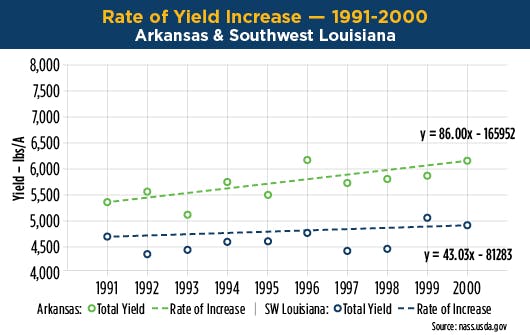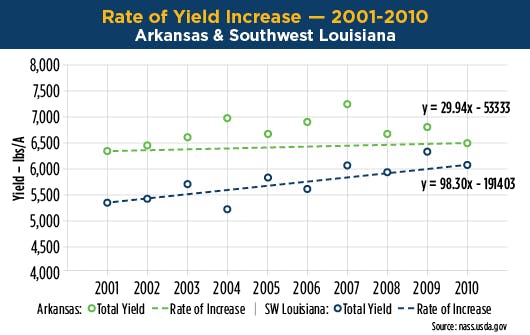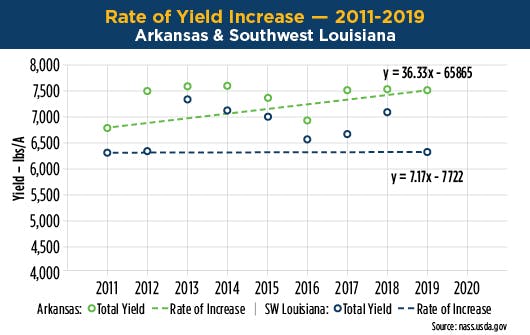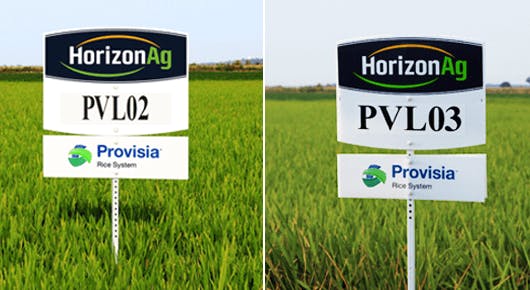Provisia Rice Enabling Farmers to Return to Drill Seeding
01/25/2021
With the availability of the Provisia® Rice System and improved Provisia rice varieties, Louisiana farmers are able to return to using the drill-seeded, delayed flood production system rather than losing agronomic efficiencies with water seeding.
Much like the Clearfield® Production System for rice revolutionized production by enabling producers to bring red rice under control, the Provisia Rice System with Provisia herbicide provides an effective tool to control weedy rice and resistant red rice that have developed into a costly problem throughout much of the South in recent years.
We can learn a lot by looking back 20 years at the dramatic impact planting Clearfield rice in a drill-seeded system had on yields in areas like Southwest Louisiana. In the decade prior to 2001, yields were relatively stagnant in the region, with most farmers water-seeding rice to achieve red rice control. With the launch of the Clearfield Production System for rice in 2001, Louisiana farmers were able to move to the drill-seeded, delayed flood system and achieve almost a 3x rate of yield increase compared to farmers in Arkansas, who were already drill seeding for the most part and didn’t see as great of an increase.


In the last 10 years, that rate of yield increase has fallen in Southwest Louisiana, particularly as the spread of weedy rice and resistant red rice pushed farmers back to water seeding. Fortunately, with the release in 2020 of PVL02, the second Provisia variety, and the advancement of PVL03, the latest Provisia line, rice farmers now have access to better-performing seed choices to use in what has been described by many farmers as the most effective weed management system available for Southern rice today.

Water seeding rice requires more seed than drill seeding in order to establish an optimum stand. The increased seeding rate is used to overcome reduced germination and seedling survival. Another potential stand establishment hazard of water-seeded rice is the potential for rice seed to move in the water prior to germination and pegging due to high winds and wave action. This seed movement can cause areas of high- and low-plant populations.
Those challenges can be avoided by drill seeding new Provisia varieties like PVL02 in the Provisia Rice System. PVL02 is a tremendous improvement over PVL01, particularly in South Louisiana and Texas. It has improved yield potential and is 7 to 10 days earlier than PVL01. That earliness works really well for the ratoon crop that is so important in the Coastal rice region.
PVL02 is a better milling rice than PVL01, whose long, slender grain tended to break more easily during the milling process. PVL02 is a much shorter grain that holds together better. We are seeing some phenomenal milling yields with PVL02. You hardly ever hear of whole milling rice measuring 70%, but one of our seed farmers this year was proud to say he had a couple of lots of rice that milled 70/73.
PVL02 also offers a slight advantage over PVL01 when it comes to disease pressure, particularly blast, since the line contains one of the blast-resistant genes. Where PVL01 was rated very susceptible to blast, PVL02 is just rated susceptible. It is rated moderately susceptible to sheath blight and Cercospora, whereas PVL01 is rated susceptible to both.
In 14 trials in Louisiana in 2019 and 2020, PVL02 out-yielded PVL01 by about 1,000 pounds per acre, making the variety, planted in a drill-seeded system, a more competitive choice when compared to planting a variety like Cheniere water-seeded, especially considering the agronomic efficiencies of drill seeding and the outstanding weed control with Provisia rice.

Horizon Ag also is planning a small launch of the latest Provisia variety, PVL03, in 2021 and a full launch in 2022. The new variety, developed at the LSU Ag Center, provides even greater yield and milling advantages over earlier Provisia variety lines. Perhaps most importantly, it has both Pi-ta and Pi-ks genes for blast resistance, which is remarkable being only five years into the launch of the Provisia system in rice.
Louisiana trials in 2019 and 2020 show PVL03 yielding almost 8,500 pounds per acre, out-yielding Cheniere and putting it on par with top-yielding Clearfield lines like CL153 in the Coastal region. The conversation with respect to whether to use the Provisia Rice System or continue to water seed with Cheniere until better varieties come along tilts heavily in favor of adopting the Provisia system with variety PVL03. We can out-perform conventional varieties, achieve the agronomic efficiencies associated with the drill-seeded system, and begin controlling the weedy rice problem that has threatened rice production in the region.
